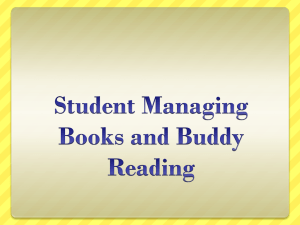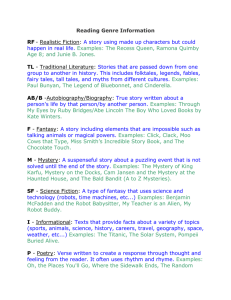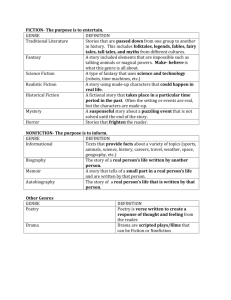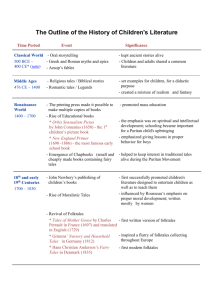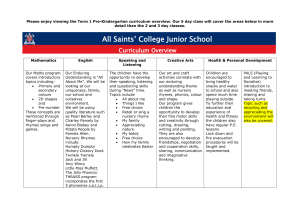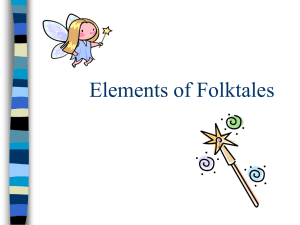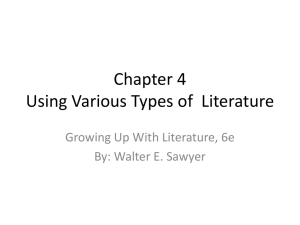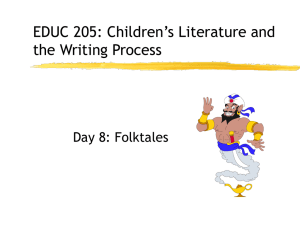Children's Literature Genres: A Comprehensive Overview
advertisement
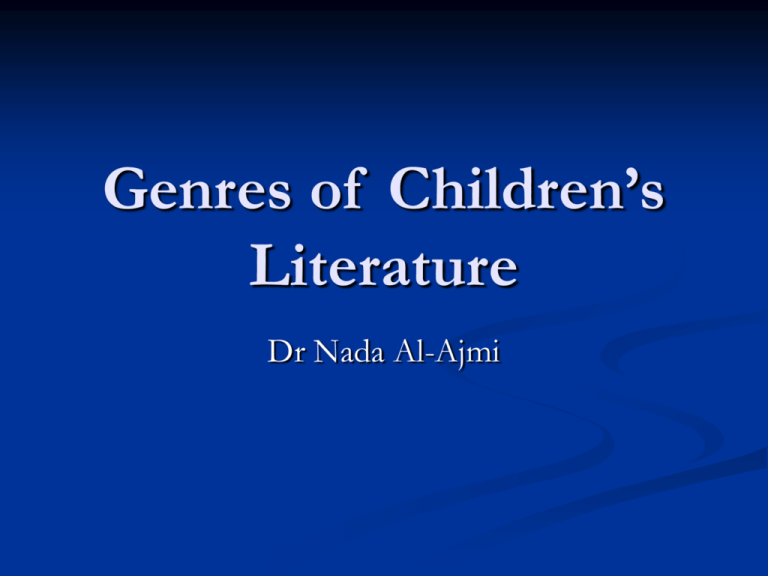
Genres of Children’s Literature Dr Nada Al-Ajmi Traditional Literature The ancient stories or poems of many cultures, originate in the oral tradition. These books are often attributed to different groups and cultures, but have no known authors. Traditional literature has been used as a way of passing down traditional wisdom and knowledge necessary for the survival of the group as well as a way of explaining features of the natural world and its creation. Traditional literature, include myths; epics; legends; tall tales; fables; folktales; and religious stories. Nursery, Lullabies, and Children’s Poetry Nursery or folk rhymes are typically a child’s first introduction to literature. Many nursery rhymes contain (fictional and absurd) violence, such as ‘down will come baby, cut off their tails, whip them all soundly’. This was assumed to help the reader and the listener vent hostilities. And anxieties to which all humans are subject. Most nursery rhymes are considered nonsensical and purely fun. Nursery rhymes contribute to a child’s cognitive development by aiding in learning of numbers and counting. Such as, ‘one,two buckle my shoe’ or alphabet such ‘A apple pie’, learning new vocabulary, memorization, developing a sense of humor (through the appreciation of the nonsense), and distinguishing fantasy from reality. It contributes to a child’s aesthetic development through the appreciation of language, rhythm in meter, concrete images and visualization and linguistic forms. It contributes to a child’s emotional development by providing comfort and security in their familiarity. It contributes to a child's social and physical development by providing a context for playful action such as clapping, skipping and jumping. Poetry Books Definition: Poetry books can range from poetry that rhymes to free verse and concrete verse. It takes the sound of language and arranges it in beautiful forms. Each word is chosen carefully for its sound and its meaning. It appeals to both the thoughts and feelings of the reader. Fantasy Refers to works of literature in which the events, settings, or the characters are outside the realm of possibility. The author must convince the reader to suspend disbelief by creating an internally logical and consistent world. There are many types of modern fantasy, including the modern fairytale (by a known author); animal fantasy; personified toys and objects; quest stories and high fantasy; time travel; and stories about miniature worlds and people. Writers can explore complex ideas on a symbolic level Exploration of philosophical issues on a level that children can understand and appreciate. Challenges our perception of reality Develops and exercises the imagination Realistic Fiction Definition: Titles dealing with the problems and joys of real life. There is often an element of character growth or self-realization in the book. Titles can promote tolerance and understanding of others and their experiences. It "extends children's horizons by broadening their interests, allowing them to experience new adventures and showing them different ways to view and deal with conflicts in their own lives" (Through the eyes of a child) Folk Literature Folktales is the collection of tales passed from generation to generation and from old to young by the word of mouth also called Oral Tradition. Folktale is believed to be people’s efforts to organize their experiences into meaningful patterns Folktales are the cement of society; they codified and reinforced the way people thought, felt, believed and behaved. Folktales are created by most people at an early level of civilization and it contains elements of past religions, rituals, superstitions or events Folktales are carried orally by migrating peoples, travelers, captives. Story tellers alter tales, combined tales and adapted tales for the lands and peoples listening. Fables A sub-genre of folk literature and a form of animal tale in which animals portray human virtue and voices for the purpose of conveying a (usually blatantly stated) moral message. Most fables require abstract thinking and are lost on young children Picture Books Definition: A book in which the picture is as important as the text. This is a genre based on a physical format, so it can contain titles from many of the other genres. It includes picture books, illustrated storybooks, wordless storybooks, concept books, and informational books. In picture books, both text and illustration are fused together, to provide more than either can do alone (the whole is greater than the sum of the parts). Illustrated story books are different from picture books in that the text can stand alone and the illustrations are secondary to the text, yet complements the text. These books are generally up to 48 pages in length. Science fiction Science fiction speculates on what might happen in the future in our universe, so it has some basis in our reality. The books in this genre address themes of love, justice, truth, loyalty, goodness, courage, wisdom, etc. Sometimes the line between fantasy and science fiction is blurred, with elements of both genres in the story. Informational Books Definition: Informational books can also be called non-fiction books. Informational books must be accurate, authentic, up-to-date, factual, clearly organized, and include illustrations when needed. These books should avoid anthropomorphism, stereotypes and generalizations. Sub-genres include photo documentaries, narrative texts, how-to books, question and answer books, activity books, field guides/identification books, survey books, concept books and life-cycle books. Fairytales It involves some fairy or witch which has magic powers through which the limitations of reality can be circumvented. Fairies or witches are usually either good or bad and one must exercise caution in requesting or accepting their assistance. Frequently, fairytales also contain moral lessons, emphasizing uses and misuses or magic. Social Satire The purpose of this type of story is to mock or satirize adult behavior. In this type of story, point of view may be important since the adult behavior may be seen through the eyes of the children.
